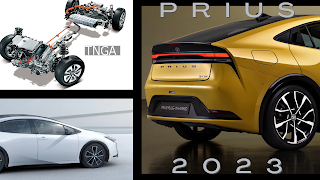When it comes to mainstream inexpensive hybrids, there aren't many record-breaking moments because they are frequently uninteresting and the EV market is where all the action is these days. So it comes as quite a surprise that the brand-new Toyota Prius was unveiled early in Europe and Japan. Toyota is behind the curve with fully electric vehicles; to date, all it has offered is the subpar (and quickly recalled) bZ4X. As a result, it says something when we become excited about one of its hybrid vehicles, especially the traditionally boring and odd Prius.
To be clear, when the 2023 Toyota Prius is unveiled in California ahead of the 2022 L.A. auto show, we'll have complete, U.S. market details and images. We're providing you with this sneak preview of what you can probably anticipate here in America because these images and details unexpectedly appeared on Toyota's official European and Japanese websites. We assume their Priuses (Prii?) are a good indication of what our Prius will look like when it makes its debut tonight.
Until recently, every Prius—with the possible exception of the ground-breaking, tadpole-shaped second-generation model—was both forgettable and odd-looking. Early hybrids like the Prius ran to a different, typically dorky rhythm, just like today's coming EVs, which are frequently fashioned to seem slightly different from regular gas cars to advertise their futuristic powertrains.
Despite having standard side mirrors, regular tires, etc., the 2023 Prius appears to be a production-ready concept car in motion. Its aggressive, pointed shape—which has been teased in recent teasers—is a nice riff on the full-width taillights and Kamm tail of the hydrogen fuel-cell Toyota Mirai. The windshield almost lies flat, the rear door handles are concealed in the area of the rear quarter window, and the wheels appear to be the right size for the Prius.
The bZ4X EV crossover's steering wheel and digital gauge cluster appear to have been borrowed by the Prius, while Toyota's newest touchscreen display is mounted on top of the dashboard. Inside and exterior, it nearly exudes elegance, and it has a slightly premium feel that no Prius has yet managed. Yes, it is the first Prius ever, and it may draw attention for reasons other than its pricing or miles per gallon rating.
Engine and performances
The Prius and its plug-in hybrid twin, the Prius Prime, are usually slow and weak vehicles, but Toyota's material for the European market suggests significant power enhancements. The output of the conventional hybrid is increased to an astounding 193 horsepower, while the plug-in Prime's is increased to 220 horsepower by swapping out the original Prius's 1.8-liter gas engine for a larger 2.0-liter one and maybe making improvements to its electric motors. Because Toyota claims the PHEV can reach 100 kph (about 60 mph) in 6.7 seconds, which is unheard of for a Prius, be prepared to perhaps have one of these Priuses rushing up your rear bumper in the left lane.
Toyota's modular second-generation TNGA platform, which currently supports almost all of its car and crossover lineups in America, is crammed with all this power. Again, complete information regarding the Prius's hybrid and plug-in hybrid systems, as well as its features and specifics for the U.S. market, will be made public tonight, but for the time being, Europe's preview has us eagerly anticipating learning more and—we can't believe we're saying this—driving this apparantly quicker, more fashionable Prius soon.



Comments
Post a Comment